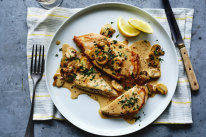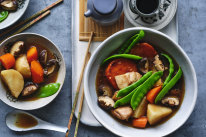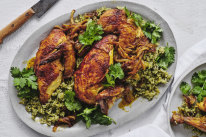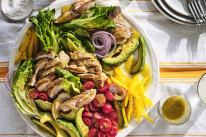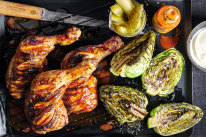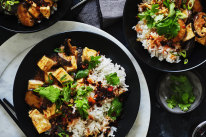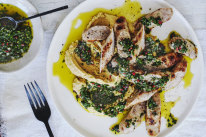Danielle Alvarez's spatchcocked roast turkey with caramelised onion gravy
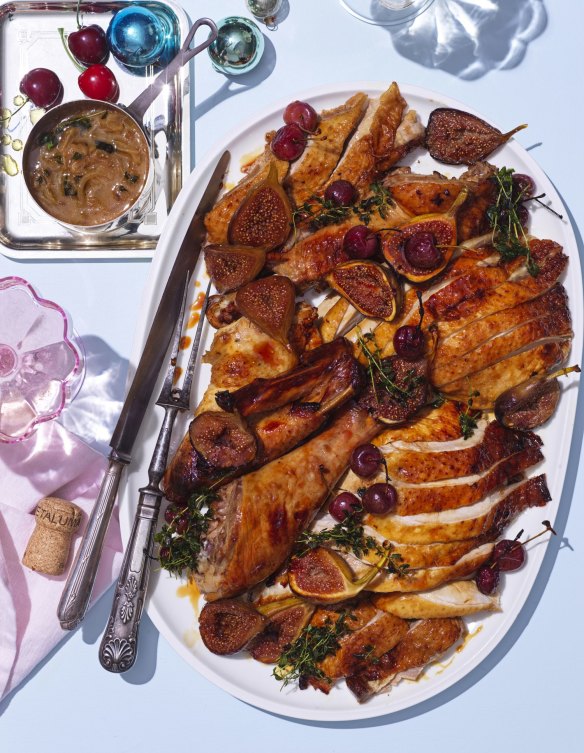
Spatchcocking means that you remove the backbone, cooking the bird flat. You won't have that quintessential whole bird presentation, but I can guarantee it will be juicier and more flavoursome, and the bonus is that it halves the cooking time. I recommend brining the bird overnight, a step I've discovered over the years is essential. Once you eat this turkey, you won't want to cook it another way ever again.
Ingredients
4-5kg whole turkey
olive oil
Brine
1.5 litres cold water
375ml can apple cider (or swap for alcohol-free)
95g salt
45g brown sugar
1 onion, peeled and quartered
4 garlic cloves, peeled and halved
1 tbsp black peppercorns
2 bay leaves
1 bunch sage
1 bunch thyme
Turkey stock
reserved turkey backbone and neck (if you have it)
750ml cold water
1 onion
1 carrot
1 stalk celery
1 bay leaf
Gravy
40g butter
200g sliced onion (2 small onions or 1 large)
60ml dry white wine
2.5 tbsp plain flour
400-500ml turkey stock
turkey dripping
1 tbsp chopped fresh thyme
salt and black pepper
Method
1. To remove the backbone, flip the turkey breast side down with legs towards you. Using good strong kitchen shears, cut through the ribs on either side of the backbone from the tail to the neck. Where the maryland connects to the backbone there is a small joint that is too thick to cut with shears. Poke the tip of a knife into the joint where the leg wants to separate, then use shears to cut around that, as close to the backbone as possible. Reserve the backbone to make stock later. Flip it back over so the breast side is up and press down on the breast firmly to flatten. You can ask a butcher to butterfly it for you (but keep the backbone).
2. Combine all the brine ingredients in a large mixing bowl or another deep container that will accommodate your turkey and fit into your fridge, mixing until the salt and sugar are completely dissolved. Place the turkey into the brine, breast side down, and place into the fridge for 12-18 hours. Ensure the turkey is 90 per cent submerged in the brine or switch to a smaller container that holds everything more snugly.
3. To make the turkey stock, heat the oven to 180C fan-forced (200C conventional) and place the reserved backbone (and turkey neck, if using) on a sheet of baking paper, and cook in the oven until it's well browned all over. This should take about 25-35 minutes. When browned, remove it from the oven and place into a stockpot with the remaining turkey stock ingredients and bring to a low, slow simmer, skimming off any fat or foam that comes to the top using a small ladle. Simmer for 1.5-2 hours then strain and chill. You should be left with about 400-500ml of brown turkey stock to make your gravy. This can be done a day ahead.
4. The following day, remove the turkey from the brine and place it breast side up on a flat roasting rack over a roasting dish and allow it to come to room temperature. This should take about 1.5-2 hours. Meanwhile, preheat the oven to 175C fan-forced (195C conventional). Just before roasting, dry the turkey skin really well with paper towels and brush the skin with olive oil. Place it into the oven and roast for 1 hour, rotating the roasting dish and basting it after 30 minutes. If, after 1 hour, the skin has not fully browned, increase the heat to 200C fan-forced (220 conventional) and roast a further 10-15 minutes until well browned. If you have a thermometer, insert it into the thickest part of the leg. It should register above 74C. Allow it to rest on the bench for at least 30 minutes but up to 1 hour.
5. Meanwhile, make the gravy by heating the butter in a medium saucepan. Add the onions and a pinch of salt and cook over low heat for 30 minutes until deeply caramelised and sweet (you can do this part ahead and set aside). Over medium heat, add the white wine and simmer until the onions are almost dry again. Next, add the flour and stir to combine, cooking for a minute. Add the stock and any turkey dripping* from the roasting dish while continuously whisking and bring to a simmer. Simmer until the consistency is to your liking. Add the chopped fresh thyme and black pepper and taste for seasoning. Adjust with salt as needed.
6. Once the turkey has rested and the gravy is made, carve the bird by first removing the wings and then cutting both breasts from the crown and slicing those breasts into 8-10 slices. You can either joint the legs, cutting the drumstick from the thigh and serving those on the bone, or cut the meat from the legs and serve the boneless meat on the platter next to the breast meat. Drizzle the whole thing with gravy and serve the remaining warm gravy on the side.
*Pour the dripping from the roasting dish into a small measuring cup, scraping the bottom of the roasting dish. Try to discard the fat so you are adding mostly rich brown liquid to the gravy.
The wine match
Cuvée Co Wines NV Brave & Duke Sparkling ShirazWrattonbully, SA, $35, 13.8 per cent alcohol.
Name a more iconic duo. Roast turkey and sparkling shiraz were made for each other. Rising star and sparkling queen Peta Baverstock makes her sparkling using Wrattonbully (Limestone Coast) fruit. It's Mrs Claus in a bottle; plump cherries, spicy Christmas cake, star anise, a dash of pepper and a savoury kick that dances with the caramelised onion flavours. As you carve the bird, take a moment to appreciate the abstract label art – a lion painted by Baverstock's youngest son. cuveecowines.com
The wild card
Stoney Rise 2021 No Clothes " No SO2 Pinot NoirTamar Valley, Tasmania, $32, 12.5 per cent alcohol
Challenge your more traditional dinner guests with a preservative-free pinot out of Tassie. Not that they'll know it's sans additives unless you tell them. This light, bright, juicy red is as fresh as it gets. Winemaker Joe Holyman is an exceptional winemaker. His handling of this estate-grown fruit is testament to that. Zero additions, fining or filtration… maximum energy. It hums with life, herbal notes and banging acidity. The fat, naked bloke on the label is a conversation starter too. stoneyrise.com
This recipe features in our Australian Christmas menu.
Appears in these collections
The best recipes from Australia's leading chefs straight to your inbox.
Sign upFrom our partners
Similar Recipes
More by Danielle Alvarez
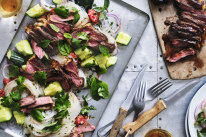
Grilled steak and vermicelli salad with spicy dressing and smashed cucumbers
- 30 mins - 1 hr
- Danielle Alvarez
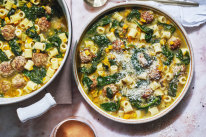
This Italian wedding soup is a marriage of flavours, and you’ll be making it on repeat
- 30 mins - 1 hr
- Danielle Alvarez
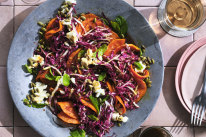
Honey-roasted pumpkin salad (featuring the trick that might change your mind about bitter leaves)
- 30 mins - 1 hr
- Danielle Alvarez

